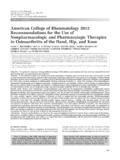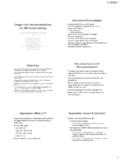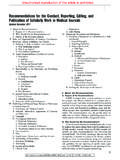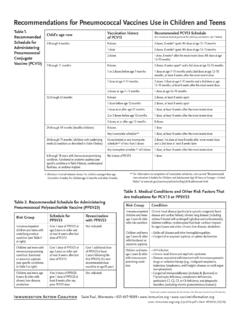Transcription of Recommendations of the Advisory Committee on …
1 Morbidity and Mortality Weekly ReportMMWR / January 26, 2018 / Vol. 67 / No. 3 103US Department of Health and Human Services/Centers for disease control and PreventionRecommendations of the Advisory Committee on Immunization Practices for Use of Herpes Zoster VaccinesKathleen L. Dooling, MD1; Angela Guo, MPH1; Manisha Patel, MD1; Grace M. Lee, MD2; Kelly Moore, MD3; Edward A. Belongia, MD4; Rafael Harpaz, MD1 IntroductionOn October 20, 2017, Zoster Vaccine Recombinant, Adjuvanted (Shingrix, GlaxoSmithKline, [GSK] Research Triangle Park, North Carolina), a 2-dose, subunit vaccine containing recombinant glycoprotein E in combination with a novel adjuvant (AS01B), was approved by the Food and Drug Administration for the prevention of herpes zoster in adults aged 50 years. The vaccine consists of 2 doses ( mL each), administered intramuscularly, 2 6 months apart (1). On October 25, 2017, the Advisory Committee on Immunization Practices (ACIP) recommended the recombinant zoster vaccine (RZV) for use in immunocompetent adults aged 50 zoster is a localized, usually painful, cutaneous erup-tion resulting from reactivation of latent varicella zoster virus (VZV).
2 Herpes zoster is common: approximately one million cases occur each year in the United States (2). The incidence increases with age, from five cases per 1,000 population in adults aged 50 59 years to 11 cases per 1,000 population in persons aged 80 years (2). Postherpetic neuralgia, com-monly defined as persistent pain for at least 90 days following the resolution of the herpes zoster rash, is the most common complication and occurs in 10% 13% of herpes zoster cases in persons aged >50 years (3,4). Among persons with herpes zoster, the risk for developing postherpetic neuralgia also increases with age (3 5).Zoster Vaccine Live (ZVL) (Zostavax, Merck and Co., Inc., Whitehouse Station, New Jersey), a 1-dose live attenuated strain of VZV, is licensed for the prevention of herpes zoster in immunocompetent adults aged 50 years and is recom-mended by the ACIP for use in immunocompetent adults aged 60 years (6).
3 Since licensure, vaccine coverage has increased each year, and by 2016, 33% of adults aged 60 years reported receipt of the vaccine (CDC, provisional unpublished data). ACIP considered use of RZV, as well as existing recommenda-tions, to develop vaccination policy which would be safe and reduce disease burden. This report serves as a supplement to the 2008 prevention of Herpes Zoster Recommendations of ACIP for the use of ZVL in adults aged 60 years and subsequent updates (6 8); it outlines recent ACIP Recommendations as well as guidance for use of RZV and ZVL in March 2015 to October 2017, the ACIP Herpes Zoster Vaccines Work Group (Work Group; see acknowl-edgments for members and their affiliations) participated in monthly or bimonthly teleconferences to review herpes zoster epidemiology and the evidence for the efficacy, safety, and programmatic factors of RZV and ZVL. According to the Grading of Recommendations Assessment, Development and Evaluation (GRADE) approach, the Work Group defined critical and important outcomes, conducted a systematic review of the evidence, and subsequently reviewed and dis-cussed findings and evidence quality ( ) (9).
4 A cost effectiveness analysis comparing RZV, ZVL, or no vaccine was conducted by CDC from a societal perspective, using an analytic horizon of time of vaccination through the end of life. Model inputs were based on published literature where available and relied on unpublished data and Work Group expert opinion when necessary. It was modeled that ZVL effectiveness against herpes zoster would wane to zero 4 12 years following vaccination, depending on age at vac-cination (4,10 13). In the absence of long-term effectiveness data, it was modeled that RZV effectiveness in adults aged 50 69 years or 70 years would wane to zero 19 years following vaccination based on the rate of waning observed during the first 4 years of clinical trials as well as expert opinion (13 15). Economic analyses were also conducted for RZV in cohorts previously vaccinated with ZVL. In keeping with CDC practice (16,17), the purpose of the economic analysis was to model the proposed recommendation; therefore, full adherence to a 2-dose RZV regime was assumed in baseline models.
5 Lower rates of 2-dose adherence were evaluated in sensitivity 2015, RZV was discussed at five ACIP meetings. In addition to the aforementioned data, several independent health economic studies (18,19), (Merck, unpublished data, 2017), as well as immunogenicity data were presented. Long-term immunogenicity of RZV (20) and immunogenicity and safety of RZV in ZVL recipients (21) were considered, with recognition that there are no standard immunologic correlates of protection for prevention of herpes the October 2017 meeting, three proposed recommen-dations were presented to the Committee , and, after a public Morbidity and Mortality Weekly Report 104 MMWR / January 26, 2018 / Vol. 67 / No. 3US Department of Health and Human Services/Centers for disease control and Preventioncomment period, were approved by the voting ACIP members as follows: 1) RZV is recommended for immunocompetent adults aged 50 years (14 voted in favor, 1 opposed*), 2) RZV is recommended for immunocompetent adults previously vac-cinated with ZVL (12 voted in favor, 3 opposed), and 3) RZV is preferred over ZVL (8 voted in favor, 7 opposed).
6 This report summarizes the data considered, the quality of evidence, and rationale for of FindingsAs a result of the GRADE process, key outcomes were designated as critical ( prevention of herpes zoster and posther-petic neuralgia, serious adverse events following vaccination) or important (duration of protection, reactogenicity). All outcomes were considered for both RZV and ZVL compared with no vaccination. There were no clinical studies that com-pared the vaccines directly with one another (head-to-head). Supporting evidence for the Work Group s findings is available online ( ) (22).Recombinant Zoster Vaccine (RZV). Efficacy of RZV was evaluated in a two-part, phase III multicenter clinical trial which enrolled >30,000 participants, who were randomized 1:1 to receive vaccine or saline placebo (14,15). The median follow-up time was years for Zoster Efficacy Study in Adults 50 Years of Age or Older (ZOE-50) (14), and years for Zoster Efficacy Study in Adults 70 Years of Age or Older (ZOE-70) (15).
7 The efficacy for the prevention of herpes zoster was (95% confidence interval [CI] = ) in persons aged 50 59 years and (95% CI = ) in persons aged 60 69 years (14). Using pooled data from both study arms, vaccine efficacy was (95% CI = ) in participants aged 70 years (15). Vaccine efficacy in the first year after vaccination was (95% CI = ) and was (95% CI = ) or higher for the remaining 3 years of the study in persons aged 70 years. Efficacy for prevention of postherpetic neuralgia was (95% CI = ) in adults aged 50 years and (95% CI = ) in those aged 70 years (15).Serious adverse events (an undesirable experience associated with the vaccine that results in death, hospitalization, disability or requires medical or surgical intervention to prevent a serious outcome) were examined in eight studies sponsored by GSK, which included 29,965 subjects (15,264 RZV recipients) (22). Overall, rates of serious adverse events over the study periods were similar in the RZV and placebo groups.
8 * Laura Riley submitted that her opposed vote was cast in error. This is reflected in the official minutes; however, because the disclosure occurred after the session was closed, the original vote remains and systemic grade 3 solicited adverse events (reactions related to vaccination which were severe enough to prevent normal activities) were actively surveyed in eight studies involving 10,590 subjects (22). Among the subset of subjects completing the 7-day diary card for reactogenicity in phase III clinical trials (9,936), of vaccine recipients reported any grade 3 adverse event compared with of placebo recipients (14,15). Grade 3 injection-site reactions (pain, redness, and swelling) were reported by of vac-cine recipients, compared with of placebo recipients and grade 3 solicited systemic events (myalgia, fatigue, headache, shivering, fever, and gastrointestinal symptoms) were reported by of vaccine recipients and of placebo recipients (14,15).
9 Whereas there were no differences in the proportions of local grade 3 reactions between dose 1 and dose 2, systemic grade 3 reactions were reported more frequently after dose 2 (1). Overall, the most common solicited adverse reactions (grade 1 3) were pain (78%), myalgia (45%), and fatigue (45%) (1).Zoster Vaccine Live (ZVL). Two randomized clinical trials and seven observational studies were reviewed to evaluate the performance of a single dose of ZVL in preventing herpes zoster (22). A randomized clinical trial in persons aged 50 59 years found that the efficacy was 70% (95% CI = 54 81) (median follow-up time was years) (12). A randomized trial in persons aged 60 years found that the efficacy was 64% (95% CI = 56 71) in persons aged 60 69 years and 38% (95% CI = 25 48) in persons aged 70 (median follow-up time was years) (4). Estimates from observational stud-ies and randomized controlled trials (RCTs) are consistent; observational estimates are within the 95% CI of the RCT estimates (22).
10 The duration of protection has been studied out to 11 years, including the first 4 years of the RCT and then follow-on, nonblinded studies which used a modeled control group from years 7 11 (4,10,11). Shorter follow-up periods have been evaluated in observational studies using administra-tive health data (22). Studies concur that there is a substantial decrease in effectiveness following the first year after receipt of ZVL, and, by 6 years postvaccination, vaccine effectiveness against herpes zoster is <35% (10,23 25). During years 7 8 postvaccination, observational study estimates of effectiveness ranged from 21% 32% (23,24). In the longest study of ZVL, estimates of effectiveness were no longer statistically significant 9 11 years postvaccination (11). In a phase III clinical trial, vaccine efficacy against post herpetic neuralgia was (95% CI = ) in persons aged 60 69 years and (95% CI = ) in participants aged 70 years (median follow-up of years) (4); these estimates are consistent with estimates from observational studies (22).


















